Articles
- Page Path
- HOME > J Musculoskelet Trauma > Volume 30(2); 2017 > Article
-
Original Article
- Radiologic Analysis of Distal Radius Fracture Accompanying Spontaneous Extensor Pollicis Longus Rupture
- Jun-Ku Lee, M.D., In-Tae Hong, M.D., Young-Woo Kwon, M.D., Gyu-Chol Jang, M.D., Soo-Hong Han, M.D., Ph.D.
-
Journal of the Korean Fracture Society 2017;30(2):63-68.
DOI: https://doi.org/10.12671/jkfs.2017.30.2.63
Published online: April 18, 2017
Department of Orthopaedic Surgery, CHA Bundang Medical Center, School of Medicine, CHA University, Seongnam, Korea.
- Correspondence to: Soo-Hong Han, M.D., Ph.D. Department of Orthopaedic Surgery, CHA Bundang Medical Center, CHA University, 59 Yatap-ro, Bundang-gu, Seongnam 13496, Korea. Tel: +82-31-780-5289, Fax: +82-31-708-3578, hsoohong@hanmail.net
- Jun-Ku Lee's current affiliation: Department of Orthopedic Surgery, Seoul Paik Hospital, Inje University College of Medicine, Seoul, Korea.
• Received: October 9, 2016 • Revised: January 15, 2017 • Accepted: February 18, 2017
Copyright © 2017 The Korean Fracture Society. All rights reserved.
This is an Open Access article distributed under the terms of the Creative Commons Attribution Non-Commercial License (http://creativecommons.org/licenses/by-nc/4.0) which permits unrestricted non-commercial use, distribution, and reproduction in any medium, provided the original work is properly cited.
- 457 Views
- 2 Download
Abstract
-
Purpose
- The spontaneous extensor pollicis longus (EPL) tendon rupture is a well-documented complication of non-displaced or minimally displaced distal radius fracture. Authors analyzed the radiographs of patients treated for closed EPL rupture after distal radius fracture.
-
Materials and Methods
- Twenty-eight patients (21 females, 7 males; average age of 58 years) with tendon transfer for spontaneous rupture of EPL after distal radius fracture were included. Wrist radiographs were taken at the first visit with EPL rupture. On the lateral view, posterior cortical displacement, distance from highest point in Lister's tubercle to fracture line, and height of the Lister's tubercle were measured. The distance from the lunate facet to the fracture line was measured on anteroposterior view. Radiologic change at the time of EPL rupture around the Lister's tubercle was evaluated by comparing it with the contra lateral wrist radiograph. Radial beak fracture pattern was also identified.
-
Results
- The interval between the injury and the spontaneous EPL rupture varied from 2 to 20 weeks, with an average of 6.7 weeks. There were 25 cases of non-displacement, 3 cases of mean 2.0 mm cortical displacement. The average distance from the lunate facet to the fracture line was 9.1 mm (3-12.1 mm), from the highest point in Lister's tubercle to the fracture line was 3.0 mm toward proximal radius (1.7-4.9 mm). The average height of the Lister's tubercle was 3.4 mm in the injured wrist and 3.1 mm in the opposite wrist. Radial beak fracture pattern was shown at 11 cases.
-
Conclusion
- All cases presented no or minimal displaced fracture, and the fracture line was in the vicinity of the Lister's tubercle. Those kinds of fractures can highlight the possibility of spontaneous EPL rupture, depites its rarity.
- 1. Duplay S. Rupture sous-cutanée du tendon du long extenseur du pouce de le main droite, au niveau de la tabatière anatomique. Flexion permanente du pouce. Rétablissement de la faculté d'extension par une opération (suture de l'extrémité de tendon rompu avec le primer radial externe). Bulletins et Mémoires de la Societé Chirurgie de Paris, 1876;2:788.
- 2. Leslie BM, Carlson G, Ruby LK. Results of extensor carpi ulnaris tenodesis in the rheumatoid wrist undergoing a distal ulnar excision. J Hand Surg Am, 1990;15:547-551.Article
- 3. Huang HW, Strauch RJ. Extensor pollicis longus tenosynovitis: a case report and review of the literature. J Hand Surg Am, 2000;25:577-579.Article
- 4. Hunt JR. Paralysis of the ungual phalanx of the thumb from spontaneous rupture of the extensor pollicis longus: the socalled drummer's palsy. JAMA, 1915;64:1138-1140.
- 5. McMaster PE. Late ruptures of extensor and flexor pollicis longus tendons following Colles' fracture. J Bone Joint Surg, 1932;14:93.
- 6. White BD, Nydick JA, Karsky D, Williams BD, Hess AV, Stone JD. Incidence and clinical outcomes of tendon rupture following distal radius fracture. J Hand Surg Am, 2012;37:2035-2040.Article
- 7. Smith FM. Late rupture of extensor policis longus tendon following Colles's fracture. J Bone Joint Surg Am, 1946;28:49-59.
- 8. Skoff HD. Postfracture extensor pollicis longus tenosynovitis and tendon rupture: a scientific study and personal series. Am J Orthop (Belle Mead NJ), 2003;32:245-247.
- 9. McKay SD, MacDermid JC, Roth JH, Richards RS. Assessment of complications of distal radius fractures and development of a complication checklist. J Hand Surg Am, 2001;26:916-922.Article
- 10. Wolfe SW. Distal radius fractures. In: Wolfe SW, Hotchkiss RN, Pederson WC, Kozin SH, Cohen MS, editors. Green's operative hand surgery. . Philadelphia: PA Elsevier; 2017. p. 576.
- 11. Denman EE. Rupture of the extensor pollicis longus: a crush injury. Hand, 1979;11:295-298.ArticlePDF
- 12. Engkvist O, Lundborg G. Rupture of the extensor pollicis longus tendon after fracture of the lower end of the radius: a clinical and microangiographic study. Hand, 1979;11:76-86.
- 13. Helal B, Chen SC, Iwegbu G. Rupture of the extensor pollicis longus tendon in undisplaced Colles' type of fracture. Hand, 1982;14:41-47.ArticlePDF
- 14. Tubiana R. The hand. Philadelphia: WB Saunders; 1981.
- 15. Bonatz E, Kramer TD, Masear VR. Rupture of the extensor pollicis longus tendon. Am J Orthop (Belle Mead NJ), 1996;25:118-122.
- 16. Hirasawa Y, Katsumi Y, Akiyoshi T, Tamai K, Tokioka T. Clinical and microangiographic studies on rupture of the E.P.L. tendon after distal radial fractures. J Hand Surg Br, 1990;15:51-57.ArticlePDF
- 17. Cho NY, Seo CY, Kim MS, Kim HS, Lee KB. Extensor pollicis longus rupture after distal radius fracture. J Korean Fract Soc, 2012;25:52-57.Article
- 18. Hove LM. Delayed rupture of the thumb extensor tendon. A 5-year study of 18 consecutive cases. Acta Orthop Scand, 1994;65:199-203.Article
- 19. Roth KM, Blazar PE, Earp BE, Han R, Leung A. Incidence of extensor pollicis longus tendon rupture after nondisplaced distal radius fractures. J Hand Surg Am, 2012;37:942-947.Article
- 20. Belsole RJ, Hess AV. Concomitant skeletal and soft tissue injuries. Orthop Clin North Am, 1993;24:327-331.
- 21. Trevor D. Rupture of the extensor pollicis longus tendon after Colles fracture. J Bone Joint Surg Br, 1950;32:370-375.ArticlePDF
- 22. Koh S, Andersen CR, Buford WL Jr, Patterson RM, Viegas SF. Anatomy of the distal brachioradialis and its potential relationship to distal radius fracture. J Hand Surg Am, 2006;31:2-8.Article
- 23. Iwamoto A, Morris RP, Andersen C, Patterson RM, Viegas SF. An anatomic and biomechanic study of the wrist extensor retinaculum septa and tendon compartments. J Hand Surg Am, 2006;31:896-903.Article
- 24. Diep GK, Adams JE. The prodrome of extensor pollicis longus tendonitis and rupture: rupture may be preventable. Orthopedics, 2016;39:318-322.
- 25. Noordanus RP, Pot JH, Jacobs PB, Stevens K. Delayed rupture of the extensor pollicis longus tendon: a retrospective study. Arch Orthop Trauma Surg, 1994;113:164-166.ArticlePDF
- 26. Navaratnam AV, Ball S, Eckersley R. Prophylactic decompression of extensor pollicis longus to prevent rupture. BMJ Case Rep, 2013;2013:pii: bcr2013010196. Article
REFERENCES
Fig. 3
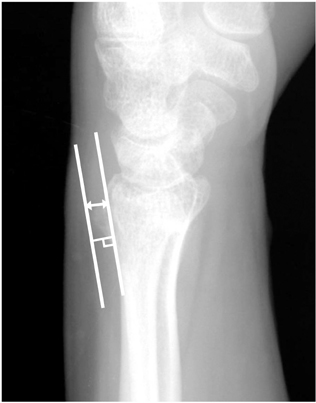
Height of the Lister's tubercle is measured from the dorsal aspect of the radial metaphysis to the highest point in the Lister's tubercle.

Fig. 4
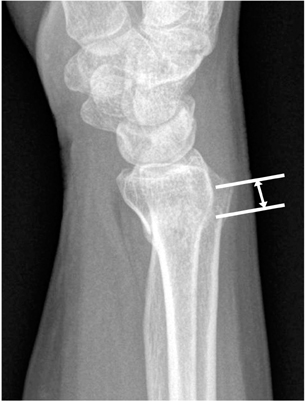
Distance from Lister's tubercle to the fracture line is measured from the highest point in Lister's tubercle to the fracture line.

Fig. 5
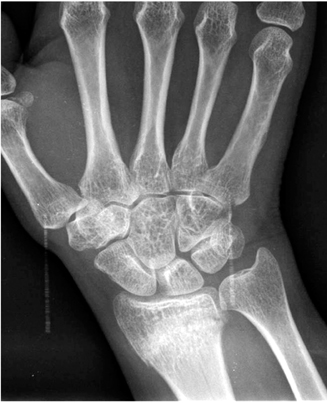
Radial beak fracture pattern shows that the fracture line deviates from transverse to proximal at the radial side.

Table 1
![jkfs-30-63-i001.jpg]()
Descriptive Values of Patients (n=28)
Table 2
![jkfs-30-63-i002.jpg]()
Fractures Included in Analysis
Figure & Data
REFERENCES
Citations
Citations to this article as recorded by 

Radiologic Analysis of Distal Radius Fracture Accompanying Spontaneous Extensor Pollicis Longus Rupture
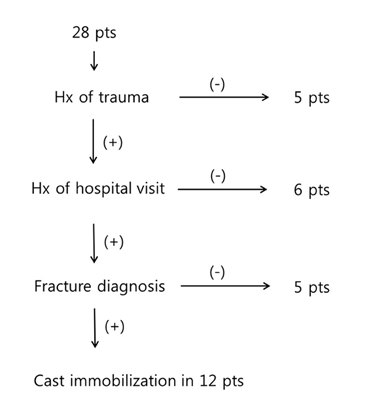
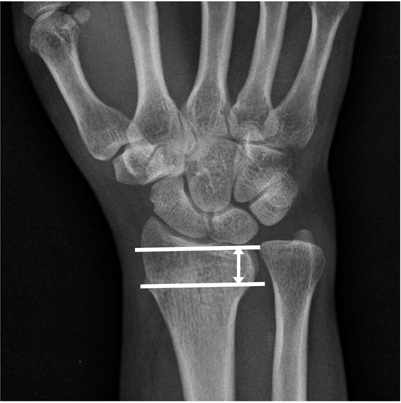



Fig. 1
Flow sheet depicts history (Hx) of study patients (pts).
Fig. 2
Distance to Fracture line is measured from lunate facet to fracture line.
Fig. 3
Height of the Lister's tubercle is measured from the dorsal aspect of the radial metaphysis to the highest point in the Lister's tubercle.
Fig. 4
Distance from Lister's tubercle to the fracture line is measured from the highest point in Lister's tubercle to the fracture line.
Fig. 5
Radial beak fracture pattern shows that the fracture line deviates from transverse to proximal at the radial side.
Fig. 1
Fig. 2
Fig. 3
Fig. 4
Fig. 5
Radiologic Analysis of Distal Radius Fracture Accompanying Spontaneous Extensor Pollicis Longus Rupture
Descriptive Values of Patients (n=28)
| Characteristic | Value |
|---|---|
| Mean age (yr) | 57.6 (16–80) |
| Gender | |
| Male | 21 (75.0) |
| Female | 7 (25.0) |
| Injured wrist | |
| Right | 13 (46.4) |
| Left | 15 (53.6) |
| Interval from trauma (wk) | 6.7 (2–20) |
| Injury mechanism | |
| Falls from standing height | 21 (75.0) |
| Falls from a greater height | 2 (7.1) |
| Obscure | 5 (17.9) |
Values are presented as median (range) or number (%).
Fractures Included in Analysis
| Evaluation factor | Length (mm) | Remark | p-value |
|---|---|---|---|
| Distance from lunate facet to fracture line | 9.1 | ||
| The height of the Lister's tubercle | 3.4 | Normal (mm): 3.1 (11 cases) | 0.199 |
| Distance from Lister's tubercle to Fracture line | 3.0 | Range (mm): 1.7–4.9 | |
| Radial beak fracture | 11 cases |
Table 1
Descriptive Values of Patients (n=28)
Values are presented as median (range) or number (%).
Table 2
Fractures Included in Analysis

 E-submission
E-submission KOTA
KOTA TOTA
TOTA TOTS
TOTS


 Cite
Cite

